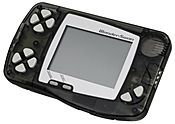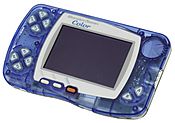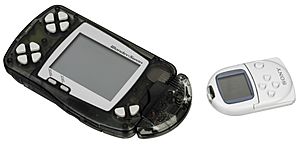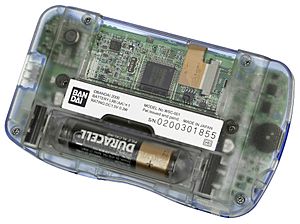WonderSwan facts for kids
 |
|
|
Top: WonderSwan
Middle: WonderSwan Color Bottom: SwanCrystal |
|
| Manufacturer | Bandai |
|---|---|
| Type | Handheld game console |
| Generation | Sixth |
| Release date | WonderSwan:
|
| Retail availability | 1999–2003 |
| Introductory price | ¥4,800 (WonderSwan) ¥6,800 (WonderSwan Color) ¥7,800 (SwanCrystal) |
| Discontinued | 2003 |
| Units sold | 3.5 million (combined) 1.55 million (WonderSwan) 1.1 million (WonderSwan Color) |
| Media | ROM cartridge |
| Power | 1 × AA battery 40 hours (WonderSwan) 20 hours (WonderSwan Color) 15 hours (SwanCrystal) |
| CPU | NEC V30 MZ |
| Memory | 512 kbit (64 KB) RAM |
| Display | FSTN (WonderSwan, WonderSwan Color) TFT LCD (SwanCrystal) 224 × 144 |
| Sound | 4 PCM channels |
| Predecessor | Design Master Senshi Mangajukuu |
| Related articles | Tamagotchi Digimon virtual pet |
The WonderSwan is a handheld game console made by Bandai in Japan. It was created by Gunpei Yokoi's company, Koto Laboratory, and Bandai. This was the last game system Yokoi worked on before he passed away in 1997. The WonderSwan came out in 1999. Its two newer versions, the WonderSwan Color and SwanCrystal, were supported until Bandai stopped making them in 2003. No WonderSwan system was ever sold outside of Japan.
The WonderSwan used a 16-bit processor. It was cheaper and had a longer battery life than its rivals, Nintendo's Game Boy Color and SNK's Neo Geo Pocket Color. Later versions got better screens and added color. You could play the WonderSwan both vertically and horizontally. It had many unique games, including ones based on popular anime shows. Big game companies like Squaresoft, Namco, Capcom, and Banpresto also made games for it.
Overall, all versions of the WonderSwan sold about 3.5 million units. It held about 8% of the Japanese handheld game market. However, it was eventually taken over by Nintendo's Game Boy Advance. People looking back at the WonderSwan often say it had a lot of potential. This was true even though it didn't sell as many units and only competed with Nintendo for a short time.
Contents
History of the WonderSwan
Bandai started in 1950 by Naoharu Yamashina. They first made toy cars and plastic models. Later, they became a big toy company by using popular anime characters. This started with Tetsuwan Atomu in 1963. In the 1970s, Bandai made LCD games and special game consoles. In 1985, they were one of the first companies to make games for the Family Computer. But their biggest success in electronic games was the Tamagotchi virtual pet, released in 1996.
Engineer Gunpei Yokoi is famous for creating the Game Boy at Nintendo. After his next project, the Virtual Boy, didn't do well, he left Nintendo in 1996. He then started his own engineering company, Koto Laboratory. Bandai asked Yokoi to create the WonderSwan to compete with the Game Boy. Yokoi helped develop the new handheld system. Sadly, he died in a car accident in 1997 before it was released.
The WonderSwan was first shown in Tokyo on October 8, 1998. Bandai chose the name "WonderSwan" because a swan is an elegant bird. They wanted to show off the system's good looks and technical abilities. Bandai promised the system would have a 30-hour battery life. They also said it would be cheap and launch with about fifty games.
The WonderSwan came out on March 4, 1999. It was available in nine colors like pearl white and skeleton green. Three special two-tone colors were also released. These colors were chosen by an online poll on Bandai's website. Nintendo had released the Game Boy Color five months earlier. But Bandai believed the WonderSwan, with its black-and-white screen, would do well. They thought this because the original Game Boy, which was also black-and-white, had beaten color systems like the Sega Game Gear. The Game Boy won because of its long battery life and good games. The WonderSwan was also cheaper than its rivals, costing ¥4,800. In 2000, Bandai planned to bring the WonderSwan to North America with Mattel. However, they decided not to. The reason is not fully known, but the many other handheld systems available might have been a factor.
Later that year, Bandai announced the WonderSwan Color . This new version had a color screen. It could still play games made for the original WonderSwan. It was released on December 9 in Japan. It came in colors like pearl blue and crystal black. The launch was pretty successful, selling over 270,000 units in less than a month. But before the WonderSwan Color came out, Nintendo announced the Game Boy Advance. The Game Boy Advance had much better hardware. The WonderSwan Color was still cheaper at ¥6,800 compared to the Advance at ¥9,800. Even though the WonderSwan reached 8% of the handheld market in Japan, its sales dropped after the Game Boy Advance came out in March 2001.
A new version of the WonderSwan Color, called SwanCrystal , was released in Japan on July 12, 2002. It cost ¥7,800, which was ¥1,000 less than the Game Boy Advance. Bandai again held a poll for the casing colors. The system came in blue violet, wine red, crystal blue, and crystal black. Despite its low price and a better LCD screen, the SwanCrystal couldn't compete. So, Bandai stopped making the WonderSwan line in 2003 because not many people were buying it. They also stopped making video game hardware completely. In total, the WonderSwan series sold 3.5 million units. Of these, 1.55 million were the original WonderSwan, and at least 1.1 million were the WonderSwan Color.
How the WonderSwan Works
The main brain, or CPU, of the WonderSwan is a 16-bit NEC V30 MZ. The first WonderSwan model's screen could show up to eight shades of gray. This was more than the Game Boy's four shades. Like the Atari Lynx, the WonderSwan had extra buttons. These buttons let you play games in different ways, either holding the system upright (portrait) or sideways (landscape). All WonderSwan systems run on a single AA battery. The original black-and-white version could last for 40 hours on one battery. You could also save your personal details like your name and birth date. Games could then use this information. The LCD screen was about 2.49 inches (6.3 cm) and had a resolution of 224 × 144 pixels. For sound, it had four PCM channels. Each channel could play sounds with different volumes and pitches.
The WonderSwan Color was a bit bigger than the original WonderSwan. It measured about 12.8 x 7.43 x 2.43 cm (5.04 x 2.93 x 0.96 inches) and weighed 96 grams (3.4 oz). Its CPU was a 3.072 MHz NEC V30 MZ. It had 512 kbit of RAM, which was used for both graphics and general work. The WonderSwan Color screen could show 241 colors out of a total of 4096. It could also display up to 28 moving images (sprites) on each line. It could play all the games made for the first WonderSwan. Its LCD screen was also larger, at 2.9 inches (7.4 cm). The WonderSwan Color's battery lasted about 20 hours.
The SwanCrystal improved on the WonderSwan Color's design. It used a TFT LCD screen, which was better than the FSTN screen in the older system. This helped make the graphics smoother and reduced blur. The system's case was also made stronger. Its battery lasted about 15 hours. The game cartridges for the original WonderSwan were solid black. The WonderSwan Color's cartridges were clear. If you played an original WonderSwan game on a WonderSwan Color, it would still be in black-and-white.
Several cool features and accessories were made for the WonderSwan. The WonderWitch was a special software development kit. It was for people who wanted to make their own games using the C programming language. An adapter was made so you could plug headphones into the system, as it didn't have a headphone port. You could also control a robot called the WonderBorg with the system. Plus, the WonderSwan could connect to a PocketStation. This was a memory card for the PlayStation console, using a device called the WonderWave. The WonderSwan and its later models could even connect to the internet using a mobile phone network.
Games for the WonderSwan

Koto Laboratories said that 10 million WonderSwan game cartridges were sold in total. Bandai worked with many game developers to create games for the WonderSwan. Banpresto, which was partly owned by Bandai, made games based on anime shows. Companies like Namco and Capcom also made games for the system. Squaresoft created remakes of Final Fantasy, II, and IV. These games later also came out on the Game Boy Advance. Taito made popular versions of games like Space Invaders and Densha de Go!.
Bandai also made its own games. These included exclusive titles from the Digimon and Gundam series. To compete with Tetris, Gunpei Yokoi developed a puzzle game called Gunpey, named after him. A sequel, Gunpey EX, was a launch game for the WonderSwan Color. Some games made using the WonderWitch kit, like Judgement Silversword, were also very good.
However, many people felt that the WonderSwan didn't get enough game support. While some well-known companies made games for it, most publishers kept making games only for Nintendo's handhelds. When Squaresoft stopped making games for the WonderSwan and went back to Nintendo, it hurt the WonderSwan's sales. After the WonderSwan was stopped in 2003, some of its games were made available on the Game Boy Advance.
Images for kids
See also
 In Spanish: WonderSwan para niños
In Spanish: WonderSwan para niños









